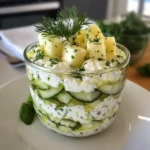Description of this recipe: This recipe guides you through the simple yet rewarding process of creating your own salt-cured duck breast at home. Known as “Magret de Canard Séché” in French, this delicacy offers a burst of savory flavor, enhanced with the aromatic notes of thyme and the subtle heat of black pepper. Curing the duck breast in salt draws out moisture and concentrates the natural flavors, resulting in a firm, intensely flavorful product. This method, while requiring some patience, is surprisingly easy and yields a product far superior to many commercially available options. Perfect as an appetizer, part of a charcuterie board, or a sophisticated addition to salads, this homemade treat is sure to impress your guests.
Why you will love this recipe: You’ll fall in love with this recipe for several reasons. Firstly, it’s a testament to the beauty of simplicity in cooking. With just a handful of ingredients – duck breast, salt, thyme, and pepper – you can create something truly special. The flavor profile is exquisite: the rich, savory duck, the herbaceous thyme, and the spicy pepper create a symphony of tastes that dance on the palate. Beyond the flavor, the process itself is incredibly satisfying. There’s something deeply rewarding about transforming a simple ingredient into a gourmet delicacy through the magic of curing. Plus, it’s a fantastic way to elevate your culinary skills and impress your friends and family with your homemade charcuterie. Finally, making your own cured duck breast is often more cost-effective than buying it pre-made, and you have complete control over the quality and origin of the ingredients.
Ingredients:
- 2 fresh duck breasts (magrets de canard), approximately 200-250g each 🦆
- 1 kg coarse sea salt 🧂
- 4 tablespoons fresh thyme, finely chopped 🌿
- 2 tablespoons freshly ground black pepper 🌶️
- Optional: 1 tablespoon juniper berries, crushed (for a more complex flavor)
- Optional: Zest of 1 orange or lemon (for added aroma)
Preparation: Step 1: Preparing the Duck Breasts Begin by carefully examining the duck breasts. Remove any excess fat that hangs loosely from the sides, but do not trim the fat cap excessively, as this fat is essential for flavor and moisture during the curing process. Pat the duck breasts dry with paper towels. This step is crucial for ensuring the salt adheres properly and draws out moisture effectively.
Step 2: Creating the Salt Bed In a large, non-reactive dish (glass or ceramic is ideal), spread a generous layer of coarse sea salt, approximately 1 cm thick. This bed of salt will form the base for curing the duck breasts. Ensure the salt is evenly distributed across the bottom of the dish.
Step 3: Seasoning the Duck Breasts In a small bowl, combine the finely chopped fresh thyme and freshly ground black pepper. If using, add the crushed juniper berries and citrus zest. Mix the ingredients thoroughly to ensure they are evenly distributed. This aromatic blend will infuse the duck breasts with delightful flavors during the curing process.
Step 4: Embedding the Duck Breasts in Salt Place the duck breasts, skin-side up, on the bed of salt in the dish. Ensure they are not touching each other. Generously sprinkle the thyme and pepper mixture (and any optional ingredients) evenly over the flesh side of the duck breasts. Then, completely cover the duck breasts with the remaining coarse sea salt. Make sure no part of the duck breast is exposed. The salt should completely encase the meat, creating an environment conducive to curing.
Step 5: Curing in the Refrigerator Cover the dish tightly with plastic wrap, pressing down gently to ensure the salt is in close contact with the duck breasts. Place the dish in the refrigerator. The curing time will vary depending on the size and thickness of the duck breasts, but generally, allow for 24-36 hours. For smaller duck breasts, 24 hours may suffice, while larger ones may require up to 36 hours. The longer the curing time, the firmer and more intensely flavored the final product will be.
Step 6: Rinsing and Drying After the curing period, remove the dish from the refrigerator. Carefully unwrap the duck breasts and rinse them thoroughly under cold running water. This is essential to remove all traces of salt and thyme/pepper mixture. Gently scrub the surface of the duck breasts to ensure no salt crystals remain.
Step 7: Drying and Seasoning (Second Stage) Pat the duck breasts completely dry with paper towels. It is vital to remove as much moisture as possible at this stage. Once dry, generously rub the duck breasts with freshly ground black pepper. You can also add a touch more thyme, if desired. This second application of pepper adds an extra layer of flavor and helps to protect the duck breasts during the drying process.
Step 8: Wrapping and Refrigerating Wrap each duck breast tightly in cheesecloth or muslin. This allows the duck to breathe while protecting it from excessive drying. Place the wrapped duck breasts in the refrigerator on a wire rack. This allows air to circulate around the duck breasts, promoting even drying.
Step 9: Final Drying and Maturation Allow the duck breasts to dry in the refrigerator for at least one week, and preferably two weeks, for optimal flavor and texture. The longer the drying period, the firmer and more flavorful the final product will be. Check the duck breasts periodically. They should feel firm to the touch and have a slightly leathery appearance.
Step 10: Slicing and Serving Once the duck breasts have dried to your liking, remove them from the refrigerator and unwrap them. Using a very sharp knife, slice the duck breasts thinly on a bias.
COOKING Rating: Easy to Medium (Requires patience and attention to detail)
Serving Suggestions:
- Serve thinly sliced as part of a charcuterie board with cheeses, olives, and crusty bread.
- Add to salads for a sophisticated and savory touch.
- Use as a topping for crostini or bruschetta.
- Pair with figs, melon, or other fruits for a delightful sweet and savory combination.
- Serve with a glass of dry red wine, such as Pinot Noir or Beaujolais.
Tips:
- Use high-quality duck breasts for the best flavor and texture.
- Ensure the salt completely covers the duck breasts during the curing process.
- Do not over-cure the duck breasts, as this can result in a product that is too salty.
- Experiment with different herbs and spices to customize the flavor.
- If you don’t have cheesecloth, you can use a clean tea towel.
- For a smoky flavor, try using smoked salt.
- Store the cured duck breast in the refrigerator for up to two weeks.
Prep Time: 15 minutes Cook Time: 0 minutes (Curing and drying time: 1-2 weeks) Total Time: 1 week 15 minutes to 2 weeks 15 minutes
Nutritional Information (per serving, approximate): Calories: 80-120 Protein: 8-12g Sodium: Varies depending on rinsing (High before rinsing)
Conclusion Making your own Magret de Canard Séché is a rewarding culinary adventure. With a little patience and attention to detail, you can create a delicious and impressive delicacy that will elevate your meals and impress your guests. The combination of rich duck flavor, aromatic thyme, and spicy pepper is simply irresistible. So, gather your ingredients, follow the steps, and enjoy the fruits of your labor! Bon appétit!
5 Questions and Answers about this Recipe:
Q1: Can I use regular table salt instead of coarse sea salt? A: While you can technically use table salt, it is not recommended. Coarse sea salt draws out moisture more gently and evenly than table salt, resulting in a better texture and flavor. Table salt can also be more easily absorbed into the duck breast, leading to an overly salty final product.
Q2: How long can I store the cured duck breast? A: Properly stored in the refrigerator, wrapped tightly in plastic wrap or cheesecloth, the cured duck breast can last for up to two weeks. Be sure to check for any signs of spoilage, such as an off odor or slimy texture, before consuming.
Q3: Can I freeze the cured duck breast? A: Yes, you can freeze the cured duck breast. Wrap it tightly in plastic wrap and then place it in a freezer bag. It can be stored in the freezer for up to three months. Thaw it in the refrigerator overnight before slicing and serving.
Q4: What if my cured duck breast is too salty? A: If your cured duck breast is too salty, you can try soaking it in cold water for a few hours before slicing. This will help to draw out some of the excess salt. You can also serve it with accompaniments that will balance the saltiness, such as fresh fruit or unsalted crackers.
Q5: Can I use different herbs or spices? A: Absolutely! Feel free to experiment with different herbs and spices to customize the flavor of your cured duck breast. Other great options include rosemary, sage, garlic powder, onion powder, paprika, and chili flakes. Just be sure to use them sparingly, as too much spice can overpower the delicate flavor of the duck.





